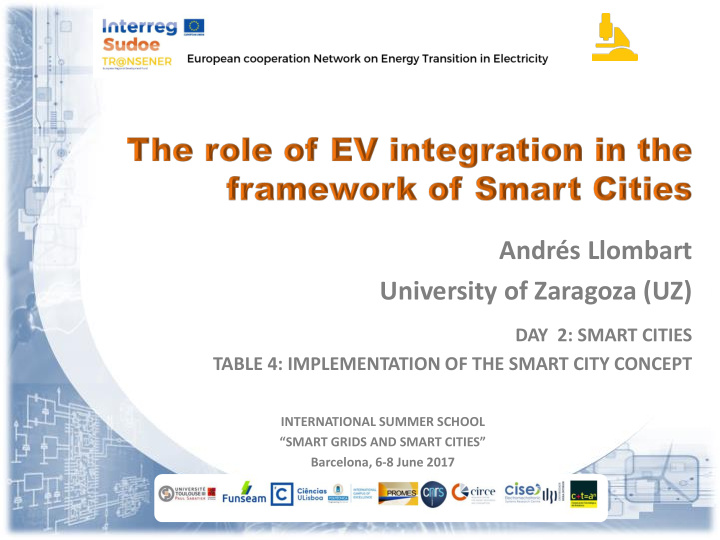



Andrés Llombart University of Zaragoza (UZ) DAY 2: SMART CITIES TABLE 4: IMPLEMENTATION OF THE SMART CITY CONCEPT INTERNATIONAL SUMMER SCHOOL “SMART GRIDS AND SMART CITIES” Barcelona, 6-8 June 2017
“A Smart City is one that ensures its energy, environmental, economic and social sustainability by incorporating innovative technologies, processes and services, to improve the citizens’ quality of life and promote business and labour activity” FutuRed. “Smart City and Social Challenges” 2016 EV impacts in every area
WINTER PACKAGE • DEVELOPMENT OF DISTRIBUTED GENERATION: – Increase in generation and storage facilities connected in the distribution network. – Appearance of active consumers in the distribution network. Change in demand profiles of users. • PROMOTION OF EV – Increase of recharge points in the building. – Recharge points will react to energy price. Night load. • In the long term VE charge fully controllable and V2G – DSO, under certain conditions, may possess recharge points • Emergence of AUXILIARY SERVICES AND FLEXIBILITY MARKETS for a better operation of the distribution network.
• EVOLUTION OF THE EV DEPLOYMENT EEA Report No 20/2016. European Environment Agency
NEW OPPORTUNITIES
VEHICLE 2 X (Grid, House, office, … ): V2X RENEWABLE GRID CITIES • Demand Response – Flexibility services • Providing ancillary services: • Voltage and Frequency Regulation • Load Leveling and Peak Power shaving • Renewable Energy supporting and balancing. • Use as electric storage for households and buildings
WIRELESS CHARGING – Public transport and Captive fleet Electrification of the transport sector will demand various technologies and solutions. Wireless charging has a less impact in urban environment Without catenaries or cables Without surface infraestructures (conductive chargers) Inaudible solution
• From the point of view of the efficiency in the end use of the energy – More efficient behavior in continuous stop and start environments, and low average speeds compared to gasoline or diesel vehicles. – Advantages mainly in urban circuits with low or medium range of action (eg routes that do not exceed 200 km a day). – Reduction of energy consumption: eg comparative reduction of energy consumption in terms of kWh / 100 km: diesel (66) vs. electric (17) approx. 74% savings. – Recommended: Vehicles with mostly urban circuits, night return to the same base and high daily use, with load preferably night and with favorable night rate. Age in year and km by model Use in KM/Year by function and age Van Intermediate Technical Supervisor Trade Address Specific control
• From the point of view of the reduction of direct emissions – Decrease in direct CO2 emissions: eg, emission reduction comparison in terms of kg CO2 / 100 km: diesel (14.3) vs. electric (5.61) approx. 61% savings. Are direct • From the point of view of economic saving: – Taking into account average gas oil price at € 0.9 / liter and price P6 € 0.054 / kWh (excluding VAT): eg, comparative economic saving in terms of € / 100 km: diesel (5.04) vs. electric (0, 93) approx. 82% of economic savings. EVOLUTION FUEL CONSUMPTION Liters / Year Total Amount Number of cars in fleet
Energy 14.779 74% Energy saving 1 vehicle saving Kwh/year Saving 2,6 According 2,5 kg CO2/l of emissions TmCO 2 /year & 0,33 kgCO2/kWh Price medium diesel 0,9 € /l Economic 1.235 Electric price P6 0,054 € /kWh saving € /year (without IVA) 7.000 Differential cost with Investment € a conventional one 6 Payback years
Thank you very much for your attention!
Recommend
More recommend